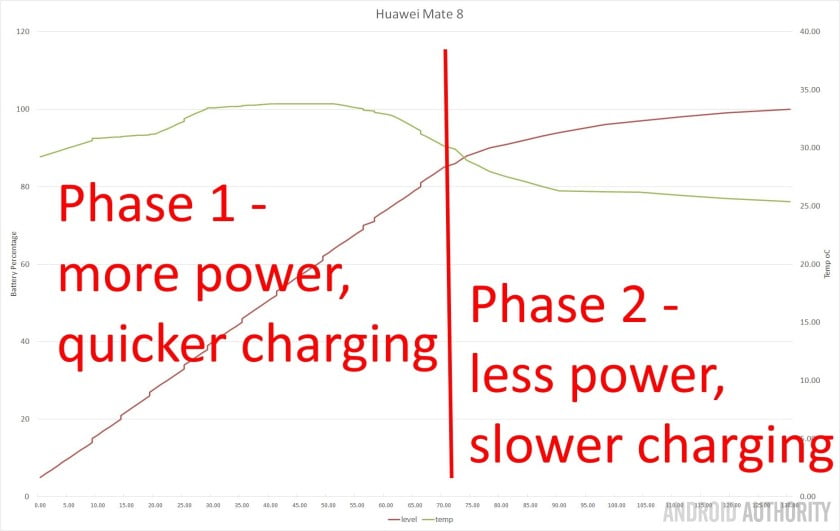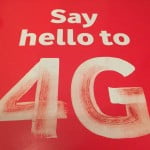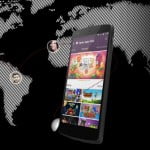When it comes to naming fast charging systems it seems that the marketing departments of the world’s smartphone makers have all been thumbing through a thesaurus to find suitable terms. Among the various names used are “fast”, “quick”, “rapid”, and “turbo.” There are a few fast charging systems with more exotic names including VOOC Flash charging and PumpExpress+. If you work for a marketing department then just let me tell you that “brisk”, “warp” and “lickety-split” are still free!
So what does all these names mean and which one is the best? To answer those questions I tested several different fast charging systems from the world’s leading OEMs to see which ones really live up to their monikers!
The first stage can be performed with a high amount of power and takes the battery up to around 80%.
Probably the best known fast charging system is Qualcomm’s Quick Charge (QC), versions 2.0 and 3.0. However it isn’t the only fast charging system. Samsung also has one called “Adaptive Fast Charging” and it is basically a re-brand of Qualcomm’s technology, as it seems from my testing to be fully compatible with QC 2.0. Motorola has its TurboPower system (which is probably also a rebrand of QC 2.0), while Oppo has VOOC Flash charging. Probably the least well known system is PumpExpress+ from MediaTek. It is also worth mentioning Huawei’s SmartPower fast charging tech that is in the Mate 8. One of the claims that Huawei make about the Mate 8 is that you can get a full day’s use out of a 30 minute charge.
How does it all work?
The basic principle of charging systems is simple. There is a re-chargeable battery which delivers energy to a smartphone over time. When the battery is depleted it needs to be re-charged. To do this the smartphone is connected to a charger. The charger puts energy back into the battery. The rate at which that energy is supplied to the battery is measured in watts. The more watts, the more power. The higher the power the quicker the battery can charge. Simple!
There is one other twist to this tale. Smartphone batteries are charged in two stages. The first stage can be performed with a high amount of power and takes the battery up to around 80%. Then the second stage kicks in where the power is reduced as the battery is topped up to full. This is why smartphone makers talk about how quickly the phone can be charged to 80%, or that just 30 minutes of charge will be enough for another 8 hours of usage, etc. This is because they are talking about charging in stage 1, up to the 80% level. Sometimes the last 20% can be as much as 50% of the total charging time, but we will look at that in more detail later on.

One final thing. Power is measured in watts and we calculate watts by multiplying the current (measured in amps) by the voltage (measured in volts). This means when you look at the small print on a charger you will see a line that says something like: “5V – 2A or 9V – 2A”. The line is actually the symbol for direct current (DC).
A normal USB 2.0 port works at 5V and 0.5A which is 2.5W. A charger running at 5V and 2A generates 10W, a fast charger using 9V and 1.67A creates 15W, and so on. Therefore the key to understanding fast charging is to see how many watts are produced by the charger, in terms of its voltage and current output, during the different charging stages.
| Charging Technology | USB 2.0 port | Typical Modern Adaptor | Qualcomm Quick Charge 2.0 | Qualcomm Quick Charge 3.0 | Oppo VOOC Flash Charge | MediaTek PumpExpress+ | Motorola TurboPower | Samsung Adaptive Fast Charger | Huawei SmartPower |
|---|---|---|---|---|---|---|---|---|---|
| Voltage | 5V | 5V | 5V / 9V / 12V | 3.2v – 20v dynamic | 5V | 5V / 9V | 5V / 9V | 5V / 9V | 5V / 9V |
| Current | 0.5A | 2A | 3A / 1.67A / 1.25A | 5A | 4A | 2A | 1.2A / 1.67A | 2A / 1.67A | 2A |
| Power | 2.5W | 10W | 15W | 18W | 20W | 18W | 15W | 15W | 18W |
The phones
To test the different charging technologies I am using the following phones:
- Samsung Galaxy Note 4 (QC 2.0)
- Samsung Galaxy Note 5 (Samsung Adaptive Fast Charge)
- Moto X Force (TurboPower)
- Oppo R7s (VOOC)
- Vivo X6D (PumpExpress+ which the X6D calls “dual-engine quick charging”)
- Huawei Mate 8 (Huawei SmartPower)
The tests
To conduct the tests I ran each phone until it had 1% battery left. I then activated a battery log app which records the battery level along with the time, the charging status, and so on. I then charged the phone up to full. During the charging I also tested the temperature on the back of the device to see how much the handset heats up during charging. I then collated all this data into the results below!
The results
First let’s look at the charging graphs. Each graph shows the battery level over time. This enables us to see how long the phone takes to charge and how quickly it reaches 50%, 80% and 100%. Also on the graph, using the right axis, is the temperature difference during the charging cycle. You will notice that during phase 1 of charging the temperature goes up and then once the battery reaches 80% the temperature starts to fall as less and less power is pumped into the battery.
- Huawei Mate 8
- Moto X Force
- Samsung Galaxy Note 5
- Oppo R7s
- Galaxy Samsung Note 4
As with all results, it is the interpretation of the data that is key to understanding what is happening. Here are a few important metrics:
So what does this all mean. The device which charged the fastest was the Vivo X6D, but that isn’t surprising as it only has a 2400 mAh battery. The Huawei Mate 8 was the slowest to charge, but again that isn’t a surprise as it has a 4000 mAh battery. To level the playing field we need to see which device adds the most charge to the battery in one minute. This is calculated by dividing the battery size by the charging time. Using this metric we can see that the Moto X Force is charged the quickest, relative to its battery size, next comes the Note 4 and then the Oppo R7s.
In terms of which phone gets to 50% the quickest, that prize goes to the Vivo X6D, again because it has the smallest battery. However if we measure the time to 50% as a percentage of the overall charge time (working on the assumption that the charge time is longer for bigger batteries) then the Moto X Force is the fastest as it takes just 29% of the overall charge time. Close behind the Moto X Force is the Vivo X6D (at 30.6%) and the Huawei Mate 8 (at 30.72%).
The R7s only heated up 3 C during the testing, quite a phenomenal achievement.
The fastest to 80% is a close call between the Vivo X6D (which managed it in 42.72 minutes) and the Oppo R7s (which got there in 42.98 minutes). However, again, the battery size is paramount as the Oppo R7s has a 3070 mAh battery compared to the X6D’s 2400 mAh unit. Using percentage of total charge time we can see that the Huawei Mate 8 is actually the fastest as it gets to 80% in just 50.7% of its charge time. Next is the Oppo R7s, followed by the Moto X Force.
As for temperature changes, it seems that around 8 C is the median with the Mate 8, Vivo X6D and the Note 5 all registering temperature differences of between 8.1 and 8.5 degrees. The exceptions are the Note 4, the Moto X Force and the Oppo R7s. The first two register higher temperatures with the Moto X Force showing a 19.9 degree temperature difference during the charge cycle. At the other end of the scale is the Oppo R7s which heated up by just 3.3 C!
 SEE ALSO: WHICH ANDROID PHONES CHARGE THE FASTEST?
SEE ALSO: WHICH ANDROID PHONES CHARGE THE FASTEST?
Wrap-up
Picking an overall winner is hard. None of the devices (and their charging systems) stood out as exceptional. If you are looking for raw charging power then it seems that the Moto X Force is the clear winner. However that raw power comes with a price, namely the near 20 degree temperature rise. If that concerns you at all, then at the other end of the spectrum is VOOC from Oppo. The R7s only heated up 3 C during the testing, quite a phenomenal achievement consider that it charging speed is similar (if not better in some circumstances) with the other systems.
If you are the kind of person that is always charging your phone for short period just to top it up then the Moto X Force (TurboPower), the Huawei Mate 8 (SmartPower) and the Oppo R7s (VOOC) look like your best option.
What do you think? Do you have a favorite fast charging system? Any experiences you want to share?
[Source:-androidauthority]
















